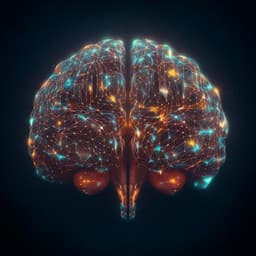
Computer Science
Universal structural patterns in sparse recurrent neural networks
X. Zhang, J. M. Moore, et al.
This research by Xin-Jie Zhang, Jack Murdoch Moore, Gang Yan, and Xiang Li delves into how sparse recurrent neural networks can match the performance of fully connected networks while being more energy and memory efficient. Their insights reveal a fascinating structural balance in optimized sparse topologies that not only enhances performance but also stretches across advanced models like Neural ODEs. A must-listen for those interested in cutting-edge network architecture!
~3 min • Beginner • English
Introduction
Recent years have witnessed the success of artificial neural networks in solving real-world problems and also the rapid increase of structural complexity and the number of parameters in various neural network models. Neural networks with a larger number of trainable parameters are more computationally and memory intensive, being difficult to deploy in embedded devices with limited hardware resources. To address this limitation, there are increasing interests to sparsify neural networks, i.e., to iteratively reduce the number of weighted links (trainable parameters) by an order of magnitude, while maintaining their performance. As shown in explorations of the Lottery Ticket Hypothesis, once initialized correctly, an optimal sub-network with similar predictive performance to the dense network can be found by iterative magnitude pruning. For example, neural networks with sparsity level 0.9 (i.e., only 10% links’ weights trainable) are able to achieve comparable performance to their fully connected counterparts in computer vision, speech recognition, and natural language processing. This phenomenon coincides with the fact that the biological brains of high intelligence and energy efficiency have actually very sparse neuronal networks. Indeed, the sparsity levels of Caenorhabditis elegans, Drosophila, and macaque brain connectome are about 0.88, 0.94 and 0.70, respectively.
Neural networks can be sparsified by either pruning or rewiring. The former starts from a fully connected network and intentionally removes its links during the training process. The latter starts from a sparse yet random network and gradually reorganizes its structure. From the renormalization group perspective, both can be viewed as inducing a flow in parameter space. While these approaches can obtain optimized sparse networks, the resulting networks have different topologies. Previous studies showed that topological properties of neural networks have a profound impact on their performance (e.g., small-world attributes, clustering coefficient, average path length, emergence of scale-free patterns, increased clusterability, and local connectivity patterns similar to CNNs after pruning).
While these results revealed the association between topological properties and the performance of neural networks, most of them focused on feed-forward neural networks, and there are currently few studies on the relationship between topological patterns and performance of sparse recurrent neural networks (RNNs). One exception is a recent study showing that the correlation between structural properties of RNNs and their performance could offer important insights into architectural search strategies. However, a fundamental question remains open: Is there a universal topological pattern in well-performing sparse RNNs?
To address this question, we explore the mesoscopic structure of RNNs from the perspective of network science, incorporating the sign of weights, which impacts performance of sparse networks. We find that the topologies of sparse RNNs optimized by both pruning and rewiring approaches show a common profile of signed three-node motifs. Our results also show that in the process of sparsification neural networks evolve towards configurations favouring feed-forward loops that are balanced (i.e., have an even number of negative weights), and this structural balance is helpful for achieving better performance. These phenomena are consistent across many different tasks and also emerge in Neural ODEs and continuous-time RNNs.
Literature Review
The paper surveys prior work on sparsification and topology-performance relations in neural networks. It references pruning and rewiring strategies that can yield sparse networks with comparable performance to dense ones, including iterative magnitude pruning (Lottery Ticket Hypothesis) and adaptive sparse connectivity methods. Prior studies linked network structure to performance: randomly wired networks with small-world properties outperform random baselines; performance correlates with clustering coefficient and average path length; evolutionary training of sparse feed-forward networks leads to scale-free connectivity; pruning increases clusterability and can induce local connectivity akin to CNNs. While these works focus largely on feed-forward architectures, limited prior research exists for RNNs, with one study indicating structural properties correlate with RNN performance and can guide architecture search. Work on the role of weight signs in sparse models is also cited, motivating analysis of signed motifs and structural balance drawn from social balance theory and motif analysis in complex networks.
Methodology
Models and tasks: The authors study single-hidden-layer RNNs across multiple tasks and datasets: MNIST, SMS spam classification (SMS), Mackey-Glass time series prediction (MG), hand gesture segmentation (HGS), and multi-task cognition (MTC). They also analyze continuous-time RNNs (CT-RNNs) and Neural ODE networks on HGS and human activity recognition (HAR).
Sparsification strategies: Four strategies are used to obtain sparse RNN hidden-layer connectivity: two pruning methods (Pruning I and Pruning II) and two rewiring methods (DeepR and SET). Pruning I progressively zeroes weights below a dynamically increased threshold ε determined by pruning schedule hyperparameters. Pruning II increases sparsity s over T pruning steps according to s_t = s_i + (s_f − s_i)(1 − (1 − t/T)^γ). DeepR updates active connection weights via gradient descent with noise (stochastic differential update), deactivating and randomly reactivating connections to maintain sparsity. SET removes, each epoch, a small fraction of weakest connections and adds an equal number of random connections, keeping parameter count fixed.
Weight dynamics analysis: For pruning-based training, the distribution of link weights is tracked from initialization (Gaussian with zero mean), after pruning (bimodal), and after fine-tuning (signs largely preserved from end of pruning to final state).
Signed motif analysis: The hidden layer is viewed as a directed signed network (edges weighted and signed). The authors compute the z-score for counts of signed three-node feed-forward motifs relative to degree-preserving randomized networks: Z = (N_0 − μ)/σ, where N_0 is motif count in the trained network and μ, σ are mean and standard deviation from the null ensemble. Eight signed feed-forward motif types are considered. A motif is structurally balanced if sign(w_ij w_jk) = sign(w_ik); otherwise unbalanced.
Global structural balance: Structural balance is quantified over transitive triads (triads containing or decomposable into feed-forward loops). For each of four transitive triad types, the fraction T_i of balanced feed-forward loops is computed; the overall balance ratio η is the average of T_i across types. FANMOD is used to enumerate motifs; NumPy and NetworkX support computations.
Generating balanced networks: To study performance effects of balance, the authors generate degree-preserving rewired networks starting from random signed directed graphs. An annealing-like rewiring minimizes energy E(x) = Σ |1 − x_i|, where x_i is local balance ratio of candidate edges. Rewiring proposals are accepted if they reduce E or with probability exp(−β ΔE), with β gradually increased, producing networks with higher global structural balance while preserving degree sequences.
Lesion experiments: Synthetic hidden-layer networks are built with a core random directed graph (edge density p) plus m tangent feed-forward motifs (each shares one core node and two peripheral nodes). After training on MNIST and MG with fixed structure, unbalanced tangent motifs are removed one by one to measure performance degradation without further training.
Effect of a single feed-forward loop: In an isolated three-node system with tanh activation (σ(0)=0, σ′(0)=1), fixing node i’s state h_i^1, the effect on node k is approximated by h_k^2/h_i^1 = w_ij w_jk + w_ik, showing alignment of direct and indirect influences in balanced motifs.
Continuous-time models: Neural ODE hidden dynamics satisfy dh_t/dt = f(h_t, x_t, θ) and are integrated by 4th-order Runge-Kutta with time step 1/6. CT-RNNs satisfy dh/dt = h/τ + f(h, x, t, θ), with τ=1 for HGS and τ=0.5 for HAR, integrated by Euler method with time step 1/6.
Data: SMS dataset preprocessing uses tokenization and word embeddings (dim 50), max sequence length 25, train/test split 8:2. MG time series is generated from a delay differential equation with τ=23, n=10, β=0.2, γ=0.1; 50,000 points (40k train, 10k test), predicting next 50 steps from 500-step histories using MSE. MTC performance is averaged across 20 cognitive tasks. HGS and HAR are segmented into overlapping 32-step sequences, with validation used for early model selection. Sparsity levels commonly s≈90–95% in hidden layers.
Key Findings
- Sparse RNNs achieve comparable performance to fully connected counterparts with only 5–10% link density (sparsity ~90–95%) across tasks (e.g., MNIST), for both pruning and rewiring strategies.
- Under pruning, weight distributions become bimodal after pruning; during fine-tuning, most connection signs remain unchanged from the end of pruning to final state.
- Across all sparsification strategies (Pruning I, Pruning II, DeepR, SET), tasks (MNIST, SMS, MG, HGS, MTC), and sparsity levels (s=0.90 and s=0.95), trained sparse RNNs exhibit a universal signed motif profile: balanced feed-forward motifs are over-represented (positive z-scores), while unbalanced motifs are under-represented (negative z-scores).
- Structural balance emerges during training: the overall balance ratio η of transitive triads increases over epochs consistently across strategies and datasets.
- Networks engineered to be more structurally balanced outperform degree-matched random networks: increases in accuracy (classification tasks) or decreases in MSE (MG) correlate with higher η; median performance changes are positive when moving from random to balanced configurations.
- Lesion experiments indicate unbalanced feed-forward motifs negatively impact performance: removing unbalanced tangent motifs improves or preserves performance compared to leaving them intact (details in supplementary figures).
- The structural balance phenomenon generalizes to CT-RNNs and Neural ODEs: sparse versions (s≈95%) match or exceed fully connected baselines on HGS and HAR, and their balance ratio increases during training for both pruning and rewiring.
- These structural patterns arise without explicit architectural constraints promoting balance, suggesting an emergent property tied to optimization dynamics.
Discussion
The study addresses whether well-performing sparse RNNs share universal structural features. By analyzing signed three-node motifs and global balance in sparsified recurrent networks, the authors demonstrate that structural balance reliably emerges during training and correlates with improved performance across diverse tasks and sparsification strategies. The over-representation of balanced feed-forward motifs implies that optimization aligns direct and indirect influences between neurons, thereby stabilizing information flow in recurrent dynamics. The increase in global balance ratio over training, along with performance gains when enforcing balanced topology and improvements after removing unbalanced motifs, supports a causal role of balance in enabling efficient sparse recurrent computation. The generalization to CT-RNNs and Neural ODEs indicates that balance is a robust property of sparse recurrent architectures beyond discrete-time RNNs, informing architecture search and providing a mesoscopic design principle drawn from network science and social balance theory.
Conclusion
The paper reveals a universal structural signature—over-representation of balanced feed-forward motifs and high global structural balance—in well-performing sparse recurrent networks. This pattern consistently emerges during training, independent of sparsification method, sparsity level, and task, and extends to CT-RNNs and Neural ODEs. Enforcing structural balance improves performance relative to degree-matched random networks, and removing unbalanced motifs mitigates performance degradation, indicating practical utility for architecture design. Future research directions include: extending balance analysis to other architectures (e.g., deep feed-forward, convolutional, transformer-based models), uncovering the statistical-physics mechanisms driving the emergence of balance during optimization, and leveraging balance-aware objectives or priors for principled sparse architecture search and training.
Limitations
- Scope limited primarily to recurrent architectures (basic RNNs, CT-RNNs, Neural ODEs); generalization to other network families (e.g., CNNs, Transformers) is not established and suggested as future work.
- Mechanistic understanding of why structural balance emerges is not yet provided; authors point to future work using statistical physics.
- Quantitative performance improvements due to enforced balance are presented relative to random baselines; broader comparisons against alternative structured sparsity priors are not detailed in the main text.
- Motif and balance analyses focus on triads/feed-forward loops; potential roles of larger motifs or higher-order structures are not explored.
Related Publications
Explore these studies to deepen your understanding of the subject.







